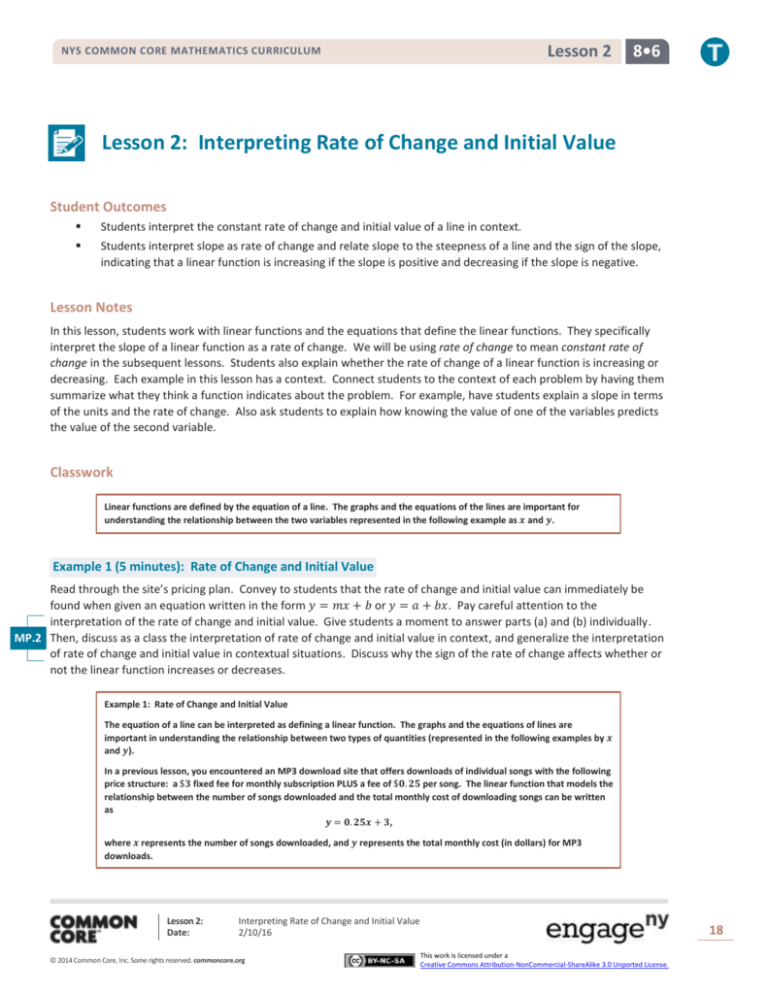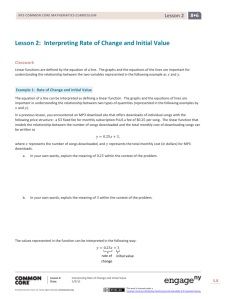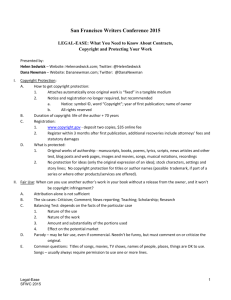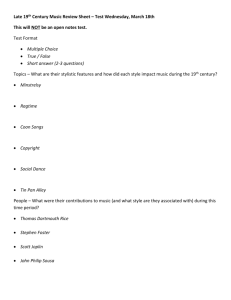
Lesson 2
NYS COMMON CORE MATHEMATICS CURRICULUM
8•6
Lesson 2: Interpreting Rate of Change and Initial Value
Student Outcomes
Students interpret the constant rate of change and initial value of a line in context.
Students interpret slope as rate of change and relate slope to the steepness of a line and the sign of the slope,
indicating that a linear function is increasing if the slope is positive and decreasing if the slope is negative.
Lesson Notes
In this lesson, students work with linear functions and the equations that define the linear functions. They specifically
interpret the slope of a linear function as a rate of change. We will be using rate of change to mean constant rate of
change in the subsequent lessons. Students also explain whether the rate of change of a linear function is increasing or
decreasing. Each example in this lesson has a context. Connect students to the context of each problem by having them
summarize what they think a function indicates about the problem. For example, have students explain a slope in terms
of the units and the rate of change. Also ask students to explain how knowing the value of one of the variables predicts
the value of the second variable.
Classwork
Linear functions are defined by the equation of a line. The graphs and the equations of the lines are important for
understanding the relationship between the two variables represented in the following example as 𝒙 and 𝒚.
Example 1 (5 minutes): Rate of Change and Initial Value
Read through the site’s pricing plan. Convey to students that the rate of change and initial value can immediately be
found when given an equation written in the form 𝑦 = 𝑚𝑥 + 𝑏 or 𝑦 = 𝑎 + 𝑏𝑥. Pay careful attention to the
interpretation of the rate of change and initial value. Give students a moment to answer parts (a) and (b) individually.
MP.2 Then, discuss as a class the interpretation of rate of change and initial value in context, and generalize the interpretation
of rate of change and initial value in contextual situations. Discuss why the sign of the rate of change affects whether or
not the linear function increases or decreases.
Example 1: Rate of Change and Initial Value
The equation of a line can be interpreted as defining a linear function. The graphs and the equations of lines are
important in understanding the relationship between two types of quantities (represented in the following examples by 𝒙
and 𝒚).
In a previous lesson, you encountered an MP3 download site that offers downloads of individual songs with the following
price structure: a $𝟑 fixed fee for monthly subscription PLUS a fee of $𝟎. 𝟐𝟓 per song. The linear function that models the
relationship between the number of songs downloaded and the total monthly cost of downloading songs can be written
as
𝒚 = 𝟎. 𝟐𝟓𝒙 + 𝟑,
where 𝒙 represents the number of songs downloaded, and 𝒚 represents the total monthly cost (in dollars) for MP3
downloads.
Lesson 2:
Date:
Interpreting Rate of Change and Initial Value
2/10/16
© 2014 Common Core, Inc. Some rights reserved. commoncore.org
18
This work is licensed under a
Creative Commons Attribution-NonCommercial-ShareAlike 3.0 Unported License.
Lesson 2
NYS COMMON CORE MATHEMATICS CURRICULUM
a.
8•6
In your own words, explain the meaning of 𝟎. 𝟐𝟓 within the context of the problem.
In the example on the previous page, the value 𝟎. 𝟐𝟓 means there is a cost increase of $𝟎. 𝟐𝟓 for every 𝟏 song
downloaded.
b.
In your own words, explain the meaning of 𝟑 within the context of the problem.
In the example on the previous page, the value of 𝟑 represents an initial cost of $𝟑 for downloading 𝟎 songs.
In other words, there is a fixed cost of $𝟑 to subscribe to the site.
The values represented in the function can be interpreted in the following way:
𝒚 = 𝟎. 𝟐𝟓𝒙 + 𝟑
rate of
change
The coefficient of 𝒙 is referred to as the rate of
change. It can be interpreted as the change in the
values of 𝒚 for every one-unit increase in the values
of 𝒙.
initial value
The constant value is referred to as the initial value
or 𝒚-intercept and can be interpreted as the value of
𝒚 when 𝒙 = 𝟎.
When the rate of change is positive, the linear
function is increasing. In other words, increasing
indicates that as the 𝒙-value increases, so does the
𝒚-value.
When the rate of change is negative, the linear
function is decreasing. Decreasing indicates that as
the 𝒙-value increases, the 𝒚-value decreases.
Exercises 1–6 (15 minutes): Is It a Better Deal?
Discuss the other site’s pricing plan. This second plan results in a different linear function to determine pricing. Let
students work independently, and then discuss as a class the linear function and compare it to the first company that is
summarized in the lesson.
Exercises 1–6: Is It a Better Deal?
Another site offers MP3 downloads with a different price structure: a $𝟐 fixed fee for monthly subscription PLUS a fee of
$𝟎. 𝟒𝟎 per song.
1.
MP.2
Write a linear function to model the relationship between the number of songs downloaded and the total monthly
cost. As before, let 𝒙 represent the number of songs downloaded and 𝒚 represent the total monthly cost (in dollars)
of downloading songs.
𝒚 = 𝟎. 𝟒𝒙 + 𝟐
2.
Determine the cost of downloading 𝟎 songs and 𝟏𝟎 songs from this site.
For 𝟎 songs, the cost is 𝒚 = 𝟎. 𝟒(𝟎) + 𝟐 = $𝟐. 𝟎𝟎. For 𝟏𝟎 songs, the cost is 𝒚 = 𝟎. 𝟒(𝟏𝟎) + 𝟐 = $𝟔. 𝟎𝟎.
Lesson 2:
Date:
Interpreting Rate of Change and Initial Value
2/10/16
© 2014 Common Core, Inc. Some rights reserved. commoncore.org
19
This work is licensed under a
Creative Commons Attribution-NonCommercial-ShareAlike 3.0 Unported License.
Lesson 2
NYS COMMON CORE MATHEMATICS CURRICULUM
3.
8•6
The graph below already shows the linear model for the first subscription site (Company 1): 𝒚 = 𝟎. 𝟐𝟓𝒙 + 𝟑. Graph
the equation of the line for the second subscription site (Company 2) by marking the two points from your work
above (for 𝟎 songs and 𝟏𝟎 songs) and drawing a line through those two points.
7
Cost of Conversion (dollars)
6
5
4
Company #1
Company #2
3
2
1
0
4.
0
1
2
3
4
5
6
Number of Songs
7
8
9
10
Which line has a steeper slope? Which company’s model has the more expensive cost per song?
The line modeled by the second subscription site (Company 2) is steeper. It has the larger slope value and the
greater cost per song.
5.
Which function has the greater initial value?
The first subscription site (Company 1) has the greater initial value. Its monthly subscription fee is $𝟑 compared to
only $𝟐 for the second site.
6.
Which subscription site would you choose if you only wanted to download 𝟓 songs per month? Which company
would you choose if you wanted to download 𝟏𝟎 songs? Explain your reasoning.
For 𝟓 songs: Company 1’s cost is $𝟒. 𝟐𝟓 (𝒚 = 𝟐𝟓(𝟓) + 𝟑); Company 2’s cost is $𝟒. 𝟎𝟎 (𝒚 = 𝟎. 𝟒(𝟓) + 𝟐). So,
Company 2 would be the best choice. Graphically, Company 2’s model also has the smaller 𝒚-value when 𝒙 = 𝟓.
For 𝟏𝟎 songs: Company 1’s cost is $𝟓. 𝟓𝟎 (𝒚 = 𝟎. 𝟐𝟓(𝟏𝟎) + 𝟑); Company 2’s cost is $𝟔. 𝟎𝟎 (𝒚 = 𝟎. 𝟒(𝟏𝟎) + 𝟐). So,
Company 1 would be the best choice. Graphically, Company 1’s model also has the smaller 𝒚-value at 𝒙 = 𝟏𝟎.
Exercises 7–9 (10–15 minutes): Aging Autos
Let students work independently, and then discuss the answers as a class. Note the linear equation provided in Exercise
8 is written in the form 𝑦 = 𝑎 + 𝑏𝑥. Students may mix up the values for rate of change and initial value. If class time is
running short, choose two of the exercises for students to work on, and assign the other exercise of the Problem Set for
homework.
Exercises 7–9: Aging Autos
7.
When someone purchases a new car and begins to drive it, the mileage (meaning the number of miles the car has
traveled) immediately increases. Let 𝒙 represent the number of years since the car was purchased and 𝒚 represent
the total miles traveled. The linear function that models the relationship between the number of years since
purchase and the total miles traveled is 𝒚 = 𝟏𝟓𝟎𝟎𝟎𝒙.
a.
Identify and interpret the rate of change.
The rate of change is 𝟏𝟓, 𝟎𝟎𝟎. It means that the mileage is increasing by 𝟏𝟓, 𝟎𝟎𝟎 miles per year.
Lesson 2:
Date:
Interpreting Rate of Change and Initial Value
2/10/16
© 2014 Common Core, Inc. Some rights reserved. commoncore.org
20
This work is licensed under a
Creative Commons Attribution-NonCommercial-ShareAlike 3.0 Unported License.
Lesson 2
NYS COMMON CORE MATHEMATICS CURRICULUM
b.
8•6
Identify and interpret the initial value.
The initial value is 𝟎. This means that there were no miles on the car when it was purchased.
c.
Is the mileage increasing or decreasing each year according to the model? Explain your reasoning.
Since the rate of change is positive, it means the mileage is increasing each year.
8.
When someone purchases a new car and begins to drive it, generally speaking, the resale value of the car (in dollars)
goes down each year. Let 𝒙 represent the number of years since purchase and 𝒚 represent the resale value of the
car (in dollars). The linear function that models the resale value based on the number of years since purchase is
𝒚 = 𝟐𝟎𝟎𝟎𝟎 − 𝟏𝟐𝟎𝟎𝒙.
a.
Identify and interpret the rate of change.
The rate of change is −𝟏, 𝟐𝟎𝟎. The resale value of the car is decreasing $𝟏, 𝟐𝟎𝟎 every year since purchase.
b.
Identify and interpret the initial value.
The initial value is 𝟐𝟎, 𝟎𝟎𝟎. The car’s value at the time of purchase was $𝟐𝟎, 𝟎𝟎𝟎.
c.
Is the resale value increasing or decreasing each year according to the model? Explain.
The slope is negative. This means that the resale value decreases each year.
Suppose you are given the linear function 𝒚 = 𝟐. 𝟓𝒙 + 𝟏𝟎.
9.
a.
Write a story that can be modeled by the given linear function.
Answers will vary. I am ordering cupcakes for a birthday party. The bakery is going to charge $𝟐. 𝟓𝟎 per
cupcake in addition to a $𝟏𝟎 decorating fee.
b.
What is the rate of change? Explain its meaning with respect to your story.
The rate of change is 𝟐. 𝟓, which means that the cost increases $𝟐. 𝟓𝟎 for every additional cupcake ordered.
c.
What is the initial value? Explain its meaning with respect to your story.
The initial value is 𝟏𝟎, which in this story means that there is a flat fee of $𝟏𝟎 to decorate the cupcakes.
Closing (5 minutes)
Consider posing the following questions. Allow a few student responses for each.
In Exercise 3, for what number of songs would the total monthly cost be the same regardless of company
selected? What visual attribute of the graph supports this answer?
7 songs; point of intersection
Just by looking at the graph for Exercise 3, which company would you select if you had 12 songs to download?
Explain why this is the better choice?
Company 1 has the lower cost for more than 7 songs since its linear model is below the Company 2
linear model after 7 songs.
Lesson 2:
Date:
Interpreting Rate of Change and Initial Value
2/10/16
© 2014 Common Core, Inc. Some rights reserved. commoncore.org
21
This work is licensed under a
Creative Commons Attribution-NonCommercial-ShareAlike 3.0 Unported License.
Lesson 2
NYS COMMON CORE MATHEMATICS CURRICULUM
8•6
Lesson Summary
When a linear function is given by the equation of a line of the form 𝒚 = 𝒎𝒙 + 𝒃, the rate of change is 𝒎 and initial
value is 𝒃. Both are easy to identify.
The rate of change of a linear function is the slope of the line it represents. It is the change in the values of 𝒚 per a
one-unit increase in the values of 𝒙.
A positive rate of change indicates that a linear function is increasing.
A negative rate of change indicates that a linear function is decreasing.
Given two lines each with positive slope, the function represented by the steeper line has a greater rate
of change.
The initial value of a linear function is the value of the 𝒚-variable when the 𝒙-value is zero.
Exit Ticket (10 minutes)
Lesson 2:
Date:
Interpreting Rate of Change and Initial Value
2/10/16
© 2014 Common Core, Inc. Some rights reserved. commoncore.org
22
This work is licensed under a
Creative Commons Attribution-NonCommercial-ShareAlike 3.0 Unported License.
Lesson 2
NYS COMMON CORE MATHEMATICS CURRICULUM
Name ___________________________________________________
8•6
Date____________________
Lesson 2: Interpreting Rate of Change and Initial Value
Exit Ticket
In 2008, a collector of sports memorabilia purchased 5 specific baseball cards as an investment. Let 𝑦 represent each
card’s resale value (in dollars) and 𝑥 represent the number of years since purchase. Each of the cards’ resale values after
0, 1, 2, 3, and 4 years could be modeled by linear equations as follows:
Card A: 𝑦 = 5 − 0.7𝑥
Card B: 𝑦 = 4 + 2.6𝑥
Card C: 𝑦 = 10 + 0.9𝑥
Card D: 𝑦 = 10 − 1.1𝑥
Card E: 𝑦 = 8 + 0.25𝑥
1.
Which card(s) are decreasing in value each year? How can you tell?
2.
Which card(s) had the greatest initial values at purchase (at 0 years)?
3.
Which card(s) is increasing in value the fastest from year to year? How can you tell?
4.
If you were to graph the equations of the resale values of Card B and Card C, which card’s graph line would be
steeper? Explain.
5.
Write a sentence explaining the 0.9 value in Card C’s equation.
Lesson 2:
Date:
Interpreting Rate of Change and Initial Value
2/10/16
© 2014 Common Core, Inc. Some rights reserved. commoncore.org
23
This work is licensed under a
Creative Commons Attribution-NonCommercial-ShareAlike 3.0 Unported License.
Lesson 2
NYS COMMON CORE MATHEMATICS CURRICULUM
8•6
Exit Ticket Sample Solutions
In 2008, a collector of sports memorabilia purchased 𝟓 specific baseball cards as an investment. Let 𝒚 represent each
card’s resale value (in dollars) and 𝒙 represent the number of years since purchase. Each of the cards’ resale values after
𝟎, 𝟏, 𝟐, 𝟑, and 𝟒 years could be modeled by linear functions as follows:
Card A: 𝒚 = 𝟓 − 𝟎. 𝟕𝒙
Card B: 𝒚 = 𝟒 + 𝟐. 𝟔𝒙
Card C: 𝒚 = 𝟏𝟎 + 𝟎. 𝟗𝒙
Card D: 𝒚 = 𝟏𝟎 − 𝟏. 𝟏𝒙
Card E: 𝒚 = 𝟖 + 𝟎. 𝟐𝟓𝒙
1.
Which cards are decreasing in value each year? How can you tell?
Cards A and D are decreasing in value as shown by the negative values for rate of change in each equation.
2.
Which card(s) had the greatest initial values at purchase (at 𝟎 years)?
Since all of the models are in slope-intercept form, Cards C and D have the greatest initial values at $𝟏𝟎 each.
3.
Which card is increasing in value the fastest from year to year? How can you tell?
The value of Card B is increasing in value the fastest from year to year. Its model has the greatest rate of change.
4.
If you were to graph the equations of the resale values of Card B and Card C, which card’s graph line would be
steeper? Explain.
The Card B line would be steeper because the function for Card B has the greatest rate of change; the card’s value is
increasing at a faster rate than the other values of other cards.
5.
Write a sentence explaining the 𝟎. 𝟗 value in Card C’s equation.
For Card C, the 𝟎. 𝟗 value means that Card C’s value increases by 𝟗𝟎 cents per year.
Problem Set Sample Solutions
1.
A rental car company offers the following two pricing methods for its customers to choose from for a one-month
rental:
Method 1: Pay $𝟒𝟎𝟎 for the month, or
Method 2: Pay $𝟎. 𝟑𝟎 per mile plus a standard maintenance fee of $𝟑𝟓.
a.
Construct a linear function that models the relationship between the miles driven and the total rental cost for
Method 2. Let 𝒙 represent the number of miles driven and 𝒚 represent the rental cost (in dollars).
𝒚 = 𝟑𝟓 + 𝟎. 𝟑𝟎𝒙
b.
If you plan to drive 𝟏, 𝟏𝟎𝟎 miles for the month, which method would you choose? Explain your reasoning.
Method 1 has a flat rate of $𝟒𝟎𝟎 regardless of miles. Using Method 2, the cost would be $𝟑𝟔𝟓
(𝒚 = 𝟑𝟓 + 𝟎. 𝟑(𝟏𝟏𝟎𝟎)). So, Method 2 would be preferred.
Lesson 2:
Date:
Interpreting Rate of Change and Initial Value
2/10/16
© 2014 Common Core, Inc. Some rights reserved. commoncore.org
24
This work is licensed under a
Creative Commons Attribution-NonCommercial-ShareAlike 3.0 Unported License.
NYS COMMON CORE MATHEMATICS CURRICULUM
2.
Lesson 2
8•6
Recall from a previous lesson that Kelly wants to add new music to her MP3 player. She was interested in a monthly
subscription site that offered its MP3 downloading service for a monthly subscription fee PLUS a fee per song. The
linear function that modeled the total monthly cost (𝒚) based on the number of songs downloaded (𝒙) is
𝒚 = 𝟓. 𝟐𝟓 + 𝟎. 𝟑𝟎𝒙.
The site has suddenly changed its monthly price structure. The linear function that models the new total monthly
cost (𝒚) based on the number of songs downloaded (𝒙) is 𝒚 = 𝟎. 𝟑𝟓𝒙 + 𝟒. 𝟓𝟎.
a.
Explain the meaning of the new 𝟒. 𝟓𝟎 value in the equation. Is this a better situation for Kelly than before?
The initial value is 𝟒. 𝟓𝟎 and means that the monthly subscription cost is now $𝟒. 𝟓𝟎. This is lower than
before, which is good for Kelly.
b.
Explain the meaning of the new 𝟎. 𝟑𝟓 value in the equation. Is this a better situation for Kelly than before?
The rate of change is 𝟎. 𝟑𝟓. This means that the cost is increasing by $𝟎. 𝟑𝟓 for every song downloaded. This
is more than the download cost for the original plan.
c.
If you were to graph the two equations (old vs. new), which line would have the steeper slope? What does
this mean in the context of the problem?
The slope of the new line is steeper because the new linear function has a greater rate of change. It means
that the total monthly cost of the new plan is increasing at a faster rate per song compared to the cost of the
old plan.
d.
Which subscription plan provides the best value if Kelly will download fewer than 𝟏𝟓 songs per month?
If Kelly were to download 𝟏𝟓 songs, both plans will cost the same ($𝟗. 𝟕𝟓). Therefore, the new plan is
cheaper if Kelly will download fewer than 𝟏𝟓 songs.
Lesson 2:
Date:
Interpreting Rate of Change and Initial Value
2/10/16
© 2014 Common Core, Inc. Some rights reserved. commoncore.org
25
This work is licensed under a
Creative Commons Attribution-NonCommercial-ShareAlike 3.0 Unported License.









